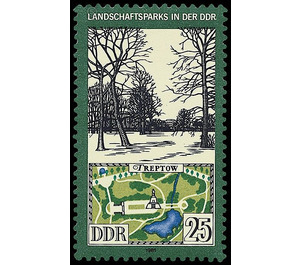landscape park - Germany / German Democratic Republic 1981 - 25 Pfennig
Theme: Architecture
| Country | Germany / German Democratic Republic |
| Issue Date | 1981 |
| Face Value | 25.00 |
| Color | multi-colored green |
| Perforation | K 12 1/2: 13 |
| Printing Type | offset |
| Stamp Type | Postage stamp |
| Item Type | Stamp |
| Chronological Issue Number | 2357 |
| Chronological Chapter | GER-DDR |
| SID | 887808 |
| In 16 Wishlists | |
Landscape parks in the GDR With motifs from landscape parks in the GDR, the Ministry of Posts and Telecommunications of the German Democratic Republic publishes six multicolored special postage stamps. Special cancellations from 9 June to 8 August 1981 Landscape parks in the GDR As early as 1720, the landscape garden in England reached its first peak, which corresponded to the changed economic conditions, especially in agriculture. A new world view had been formed in which nature was the all-encompassing and all-pervading power. This idea of nature is most clearly represented in Germany by the bourgeois enlightenment of the eighteenth century. It was the rejection of absolutism that became visible in the art of gardening through the inclusion of the natural in gardens hitherto characterized by regular geometrical features. In the German states this development starts in the middle of the 18th century. At the end of the century, the design of the gardens evolved from the depiction of the outdoors, a kind of wilderness, to a series of different scenes with different moods. In the further development of these aspirations are abandoned and it dominate in the first half of the 19th century, the magnificent landscapes, formed from the natural elements of the landscape with the visual axis and with a related to the spatial experience route. In this phase Germany finds the climax in the development of the landscape garden. The urge to small detail and intimacy ultimately leads to the abandonment of the holistically shaped spatial composition, which could hardly experience an increase in its aesthetic-creative appearance. The reasons for this lie in the increasing capitalist development. The proletariat formed itself as a progressive force and presses for a change in social conditions. In the second half of the nineteenth century, especially in the industrial cities, new tasks were confronted with gardening. There are demands for recreational areas in the form of folk gardens and folk parks. Initially, the landscape characteristics are still decisive, but at the turn of the century, more regularly designed areas in the facilities occur again. They announce the end of this significant developmental period in garden art. The six illustrated facilities in this special postage stamp series show the development of the landscape park on the territory of the GDR. They belong to a large number of surviving facilities, the care of which is guaranteed by the Historic Preservation Act of 19 June 1975. 25 Pfennig value: Berlin Treptow 1876 was begun after a design Gustav Meyers with the execution work for a public park, the Treptower park. This facility met the social demands of the time for lawns and areas for play and sport. From 1947 to 1949, the Soviet War Memorial was built according to the designs of Bjelopolski. Shown is the large lawn on the Pushkin Avenue.


